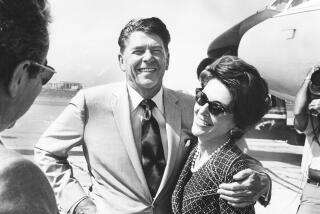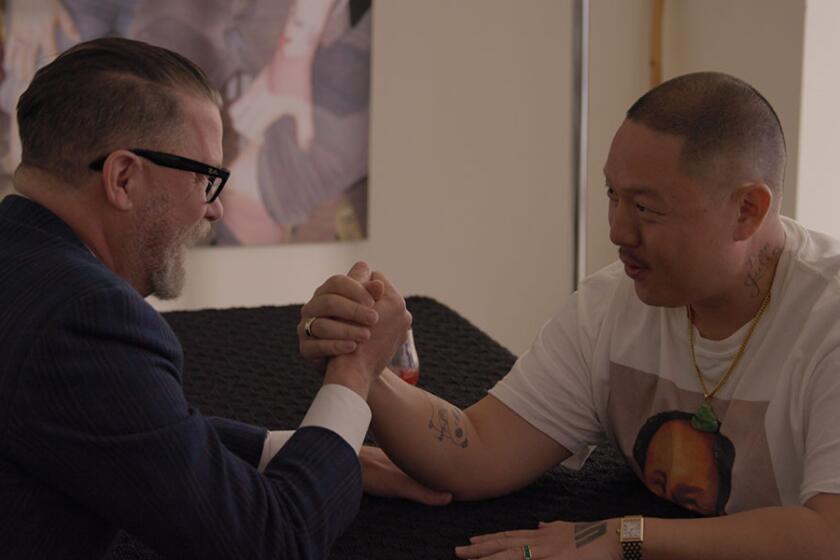‘Exile’ Recalls Dark Days of Hollywood
When Ronald Reagan and Nancy Davis reported to the set of “Hellcats of the Navy” in 1956--the only movie in which the future president and first lady appeared together--they did not suspect that their lines had been written for them by a former Communist Party member who had managed to beat the Hollywood blacklist by writing under pseudonyms and using other writers as “fronts” to sell his work.
The screenwriter’s real name was Bernard Gordon, and he tells the remarkable tale of how he survived the McCarthy era in “Hollywood Exile or How I Learned to Love the Blacklist” (University of Texas Press, $34.95, 303 pages).
“This was long before Reagan’s state or national political triumphs,” Gordon recalls, “but at the time, everyone in Hollywood knew he had played a major role in creating and enforcing the blacklist.”
Gordon was served with a subpoena to appear before the House Un-American Activities Committee in 1952, but he was never called to testify.
“I suppose that almost 50 years later, I am still on call,” he cracks in the book. Still, his long career as a screenwriter and a producer, ranging from such cult classics as “The Day of the Triffids” to such big-screen spectacles as “El Cid” and “55 Days at Peking,” was haunted by the fact that his name appeared on the blacklist. And his memoir is an unsentimental and unapologetic account of the price he paid for his politics.
Gordon, for example, is not coy about his membership in the Communist Party. He joined while working as a script analyst for the Hollywood studios, and his party unit--”a ‘club,’ never called a ‘cell’ “--consisted of six or eight other script readers who met once a week to talk politics rather than plot the overthrow of the government.
The principal responsibility of party members, he insists, was to sell subscriptions to the People’s World, the official Communist daily newspaper. And he argues that party membership, especially after the invasion of the Soviet Union by Nazi Germany, ought to be understood as an expression of the loftiest ideals rather than as a cynical conspiracy.
“Viewed from the perspective of that time, the question for me then became not why join the party but how can a principled, self-respecting person refuse?” he muses out loud. “It was simply a question of which side you were on.”
Gordon’s book is not a manifesto, and he does not neglect the high jinks that we have come to expect in books about show business. Gina Lollobrigida, for example, refused to submit to an insurance physical for a spaghetti western called “Bad Man’s River.” “I know these doctors,” she complained. “They just want to look up under my skirt!” And the badinage between actor Lee van Cleef and producer Milton Sperling over the mechanics of a semi-nude love scene in the same picture is not printable in a family newspaper.
But Gordon’s first and enduring passion is politics, and he brings a certain edginess to “Hollywood Exile” that is not often found in other show business memoirs. He recalls, for instance, how the young woman who would become his wife, Jean Lewin, worked with luminaries such as Bette Davis and Jules Stein in setting up the Hollywood Canteen, a club where servicemen on leave during World War II could mingle with stars and starlets.
But Jean soon found herself in a struggle over an issue of racism: “What was to be done if a black serviceman asked a white girl to dance?” The solution, Gordon explains, was a race-neutral policy:
“Hostesses [were] free to refuse invitations from anyone--too short, too tall, too hairy, too bald, too sweaty or whatever--without reference to race.”
“Hollywood Exile” is a colorful and compelling account of a life in Hollywood during its darkest years. At the same time, it is a primer on strategies for survival in the movie industry, no less relevant today than 50 years ago. Above all, it is the heartfelt confession of an unreconstructed radical who has refused to change his colors, then or now, to blend into the landscape.
*
On Feb. 25, 1942, the Japanese launched an air raid on Southern California--or so the panicky residents of wartime Los Angeles believed.
“At 2:25 a.m., the region’s anti-aircraft batteries went into full action, guns ablaze, firing into the search-lit skies against incoming enemy aircraft,” recalls Arthur Verge, one of the contributors to “The Way We Really Were: The Golden State in the Second Great War,” edited by Roger W. Lotchin (University of Illinois Press, $44.95, cloth; $16.95, paper; 245 pages). “While some plane spotters would later claim that they had indeed seen an enemy plane, others blamed jittery nerves and a wayward weather balloon for the spectacular fireworks show that is remembered today in a humorous vein as ‘The Battle of Los Angeles.’ ”
Such moments of humor and nostalgia can be found in the pages of “The Way We Really Were,” but the book is a sober--and sobering--study of how World War II shaped and, often enough, distorted the California Dream.
Indeed, “The Way We Really Were” reminds us that California as we know it today, is the result of the efforts, sometimes heroic and sometimes heartbreaking, to turn California into an arsenal and a staging area for military operations in the Second World War. Orchards and bean fields were turned into factory sites, and scenic stretches of coastline became shipyards. A million civilians poured into the state in search of work, and a million fresh recruits were trained to fight in the deserts of Southern California. Significantly, the word “smog” was coined in 1943 to describe the air pollution created by defense plants that operated around the clock.
Still, the war years helped to redefine California in positive ways too. It was during World War II, for example, that “Central Avenue became the jazz thoroughfare of the West.” The so-called “Rosie the Riveter” paradigm opened new opportunities for women in both politics and the workplace. By a cruel irony, the internment of Japanese Americans raised the consciousness of African Americans and Mexican Americans: “If native-born Americans of Asiatic descent can be denied all civil rights and civil liberties,” the NAACP observed in a wartime publication, “what about Americans of African descent?”
If social and political conflict is a running theme of the 10 essays in “The Way We Really Were,” so is the redemptive quality of the war effort in California. “Women and blacks fought for white male jobs; Mexicans sought to work next to Americans; and zoot-suiters and sailors brawled over girlfriends, turf and culture in the streets of Los Angeles,” observes editor Roger Lotchin. “All this was true, yet home front warriors played as hard as they worked and feuded.”
More to Read
Only good movies
Get the Indie Focus newsletter, Mark Olsen's weekly guide to the world of cinema.
You may occasionally receive promotional content from the Los Angeles Times.










